Are you torn between choosing Waldorf vs Montessori education for your child? Do you find it difficult to decide which approach best supports their development? How do you choose the right educational path that aligns with your child’s unique personality, learning style, and needs?
Choosing the right educational approach for your child is crucial, and understanding the differences between Waldorf vs Montessori methods is the first step in making an informed decision. Both philosophies focus on nurturing the child’s individuality, creativity, and social development, but each has a distinct approach.
Understanding how these two educational models align with your child’s growth can make a difference in how they experience learning. In this article, we’ll dive deep into the Waldorf vs Montessori philosophies, compare their core principles and educational strategies, and how they cater to the diverse needs of children at different developmental stages.
What is Waldorf Education?
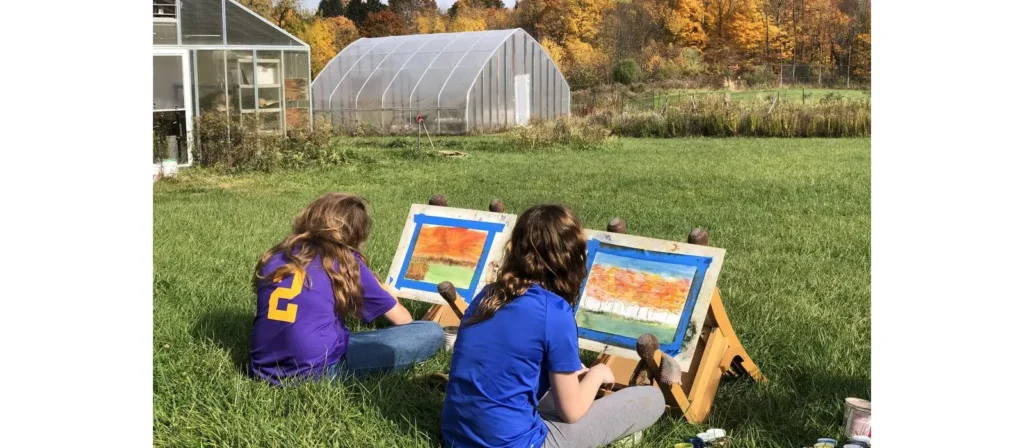
Waldorf education, founded by Rudolf Steiner in 1919, emphasizes the integration of intellect, emotion, and practical skills. It fosters a nurturing environment where children grow as well-rounded individuals, prioritizing creativity, community, and a strong moral compass.
History of Waldorf Education
The Waldorf education system traces its origins to 1919 in Stuttgart, Germany. It was founded by Rudolf Steiner, an Austrian philosopher, scientist, and social reformer. Steiner’s educational vision was deeply influenced by his philosophical framework, Anthroposophy, which emphasizes a holistic approach to human development, integrating life’s intellectual, emotional, and spiritual dimensions.
The first Waldorf school was established for workers’ children at the Waldorf-Astoria cigarette factory. Emil Molt, the factory’s owner and a supporter of Steiner’s ideas, invited him to create a new type of school that would address the needs of the post-World War I era. This marked the beginning of the Waldorf education movement, with the school focusing on cultivating academic skills, creativity, moral responsibility, and social awareness.
The success of the first Waldorf school led to the rapid spread of the method. By the 1920s, Waldorf schools began appearing in other parts of Europe, and eventually, the movement spread to North America, South America, Asia, and Africa. Today, there are over 1,200 Waldorf schools and 1,900 kindergartens worldwide, making it one of the largest independent educational movements globally.
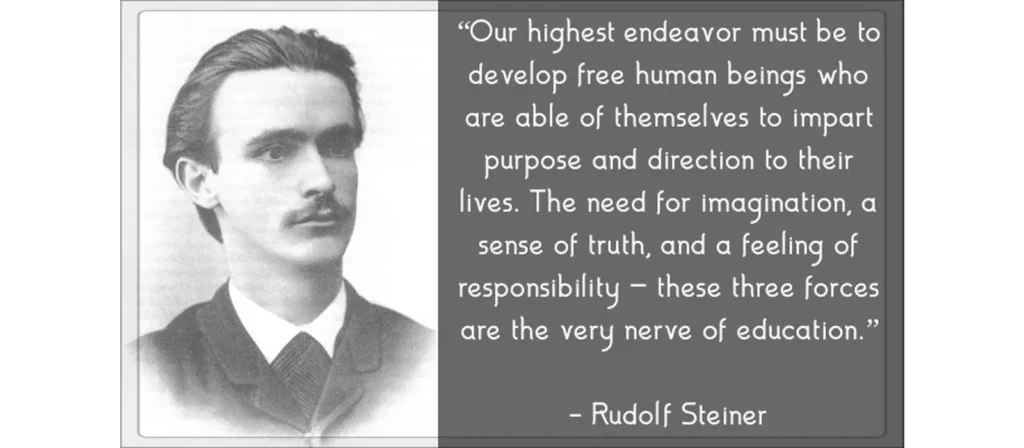
Key Principles of Waldorf Education
1. Holistic Development
- Focuses on nurturing the head (thinking), heart (feeling), and hands (doing) to ensure balanced growth in intellectual, emotional, and physical domains.
- Education addresses the whole child, fostering creativity, critical thinking, and social responsibility.
2. Developmentally Appropriate Curriculum
Tailor teaching methods and content to align with the three stages of child development:
- Early Childhood (0–7 years): Emphasizes play, imitation, and sensory experience.
- Middle Childhood (7–14 years): Focuses on imaginative and artistic learning.
- Adolescence (14+ years): Encourages abstract thinking, critical reasoning, and self-reflection.
3. Artistic and Practical Integration
- Subjects are taught artistically, incorporating music, painting, handwork, and drama to make learning engaging and memorable.
- Hands-on activities like gardening, woodworking, and cooking develop practical skills and real-world connections.
4. Imagination and Storytelling
- Storytelling is central to igniting the imagination and conveying moral and cultural lessons, especially in early grades.
- Teachers weave lessons into narratives that resonate with the student’s developmental stage.
5. Relationship-Centered Education
- Teachers often stay with the same class for several years, fostering a strong teacher-student bond.
- Emphasis on building a close-knit community among students, parents, and teachers.
6. Minimal Use of Technology
- Encourages hands-on, experiential learning over screen time, particularly in early education.
- Advocates for a technology-free environment in the classroom to promote creativity and interpersonal interaction.
7. Nature Connection
- Strong emphasis on outdoor education, gardening, and connection with the natural world.
- Seasons and rhythms of nature are integrated into the curriculum to instill environmental awareness and respect.
8. Delayed Academic Instruction
- Formal academic learning, such as reading and writing, is often introduced later than in traditional education, typically around age seven.
- Early childhood education focuses on play and movement to build a foundation for later academics.
9. Teacher Autonomy
- Teachers are trusted to adapt the curriculum creatively to suit the needs of their students rather than following a standardized model.
- This approach encourages innovation and responsiveness to individual learning styles.
10. Moral and Ethical Development
- Aims to develop ethical, socially conscious individuals who value truth, beauty, and goodness.
- Fosters empathy, cooperation, and responsibility through group activities and community service.
Benefits of Waldorf Education:
- Focus on Imagination: Integrating storytelling, art, and movement allows children to develop their creativity and problem-solving skills.
- Personalized Learning Pace: Children can learn naturally by focusing on developmental stages.
- Community-Oriented: Emphasis on collaboration and relationships fosters a strong sense of belonging.
Challenges of Waldorf Education:
- Limited Academic Rigor Early On: Some critics argue that Waldorf delays the introduction of formal academics like reading and math.
- Resistance to Technology: In an increasingly digital world, the lack of early tech exposure might be seen as a disadvantage.
- Coût: Private Waldorf schools can be expensive, making them inaccessible for some families.
What is Montessori Education?
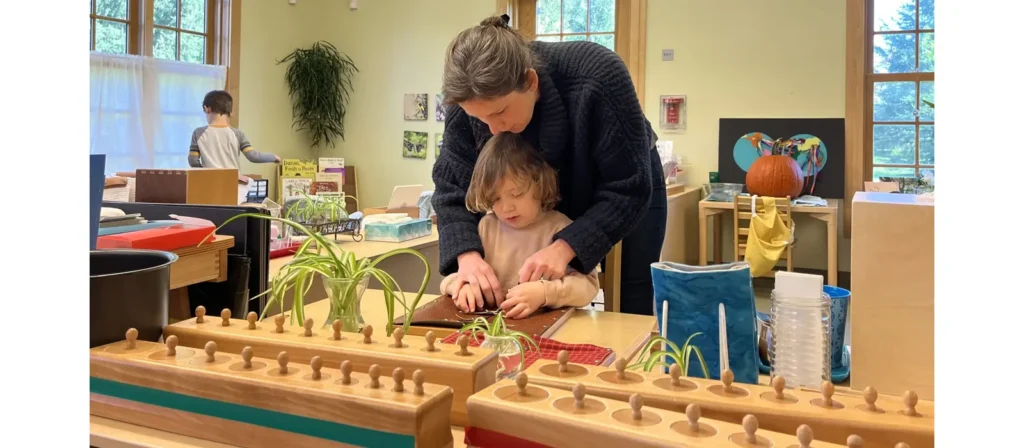
Montessori education, an innovative approach to learning, was founded by Dr. Maria Montessori, an Italian physician and educator. Her method is rooted in scientific observations of children’s natural learning tendencies, which she first developed in the early 20th century.
History of Montessori Education
The Montessori method originated in 1907 when Dr. Montessori opened her first classroom, the Casa dei Bambini (Children’s House), in a low-income district of Rome. She was tasked with caring for young children while their parents worked. Observing their behavior, she noticed that children thrived when provided with hands-on activities and the freedom to explore within a structured environment.
By the 1910s, the Montessori method gained international recognition. Dr. Montessori began training teachers and developing materials that supported her philosophy. Montessori schools were established across Europe, the United States, and other parts of the world.
During the mid-20th century, Montessori education faced challenges, including skepticism from traditional education systems and political turmoil during World War II. However, in the 1950s and 1960s, interest was resurgent in her methods, particularly in the United States, driven by parents and educators seeking alternatives to conventional schooling.
Today, the Montessori method is practiced worldwide, with thousands of schools across continents. It has influenced modern educational theories and practices, emphasizing the importance of student choice, experiential learning, and fostering a lifelong love of learning.
Key Principles of Montessori Education
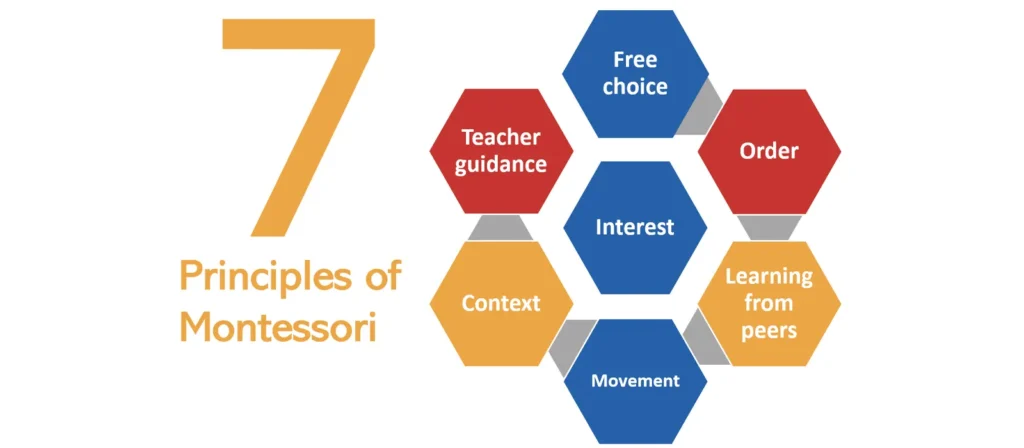
1. Child-Centered Learning
- Education is tailored to each child’s unique needs, abilities, and interests.
- Children progress at their own pace rather than adhering to standardized benchmarks or rigid curricula.
2. Prepared Environment
- Classrooms are carefully designed to encourage independence, exploration, and creativity.
- Materials and activities are organized, accessible, and appropriate for the child’s developmental stage.
- The environment fosters order, beauty, and simplicity, helping children focus and engage.
3. Hands-On Learning
- Montessori emphasizes tactile and experiential learning through specially designed materials.
- Children use materials that engage their senses, promoting understanding through active exploration rather than passive instruction.
4. Freedom Within Limits
- Students can choose activities and work independently, but a structured framework and respectful boundaries guide this freedom.
- This balance helps children develop decision-making skills, responsibility, and self-discipline.
5. Respect for the Child
- Teachers respect children, honoring their preferences, interests, and natural learning rhythms.
- Discipline is approached positively, focusing on collaboration and guidance rather than punishment.
6. Focus on Sensitive Periods
- Montessori identifies “sensitive periods” in a child’s development when they are particularly receptive to learning specific skills.
- Teachers and materials are aligned with these critical windows to maximize learning potential.
7. Auto-Education
- Montessori education believes children can self-educate with the right tools and environment.
- Teachers act as guides or facilitators, observing and supporting rather than directing every activity.
8. Mixed-Age Classrooms
- Classes typically include children of varying ages (e.g., 3–6 years, 6–9 years) to encourage peer learning.
- Younger children learn by observing older ones, while older children reinforce their knowledge by mentoring younger peers.
9. Intrinsic Motivation
- Montessori avoids external rewards like grades or prizes, fostering intrinsic motivation and a genuine love for learning.
- Children are encouraged to pursue their interests and find joy in their achievements.
10. Holistic Development
- The Montessori method addresses intellectual growth and emotional, social, physical, and moral development.
- Activities promote independence, critical thinking, empathy, and collaboration.
11. Role of the Teacher
- Teachers, known as guides, observe and respond to the needs of each child without dominating the learning process.
- They prepare the environment, introduce materials, and step back to let children explore and discover.
Benefits of Montessori Education:
- Encourages Independence: Children develop decision-making and problem-solving skills through self-directed activities.
- Hands-On Learning: Montessori materials are designed to make abstract concepts tangible and easier to understand.
- Focus on Practical Life Skills: Activities like cooking, cleaning, and gardening teach children valuable life skills alongside academics.
Challenges of Montessori Education:
- Structure Can Be Overwhelming: The freedom to choose activities might be difficult for some children to manage.
- Cost and Availability: Like Waldorf, Montessori schools can be costly and unavailable in all areas.
- Teacher Training: Inconsistent teacher training can lead to variations in quality across Montessori programs.
Classroom Environment: Waldorf vs Montessori
Choosing the right educational environment for your child is essential for their growth and development. The classroom setting plays a crucial role in shaping a child’s learning experience, and both Waldorf vs Montessori approaches strongly emphasize creating environments that support and nurture the child’s natural curiosity and learning. However, the physical space and overall atmosphere in Waldorf vs Montessori classrooms are designed differently to align with each educational philosophy.
The Waldorf Classroom Environment
The Waldorf classroom is designed to promote a warm, welcoming, and aesthetically pleasing environment where children feel safe, inspired, and encouraged to engage their creativity. The space is often described as organic, cozy, and sensory-rich, strongly connected to nature and artistic expression. Here are some key characteristics of the Waldorf education classroom environment:

1. Emphasis on Natural Materials
One of the hallmarks of a Waldorf school classroom is the use of natural materials. From the furniture to the toys and decorations, Waldorf vs Montessori classrooms prioritize items made from wood, wool, cotton, and other natural elements. These materials are thought to create a more grounded, tactile, and sensory-rich experience, central to Waldorf’s emphasis on the child’s connection to nature. Using these organic materials encourages creativity and imagination, as children are inspired to engage with objects that are not overly structured or plastic.
2. The Role of Light and Color
In Waldorf vs Montessori classrooms, light plays a significant role. Natural light is preferred over artificial lighting, as it helps create a calming atmosphere. Soft, warm colors, especially earth tones, are key features. These colors are considered soothing and contribute to security and peace. Walls and classrooms are often painted in gentle shades like warm yellows, soft reds, and light greens, providing a harmonious and balanced visual environment for children to learn.
3. Flexible and Artistic Space Layout
Waldorf vs Montessori education is distinct in the way the classroom is arranged. Waldorf classrooms are organized in a way that encourages both movement and creativity. The space is often flexible, with areas for imaginative play, artistic expression, and more structured academic activities. There is a distinct absence of rigid rows of desks or traditional “classroom-style” seating. Instead, the environment is designed to allow children to move freely, work individually or in groups, and engage in creative projects.
In early childhood, Waldorf education may have a large central play area where children can interact with open-ended, creative materials like blocks, paints, and drawing supplies. As children grow older, the focus shifts to more structured areas where children engage in creative learning projects that combine academics and artistry. For example, math and science might be integrated with physical activities, storytelling, or craft projects.
L'environnement de la classe Montessori
The Montessori school vs Waldorf school environment is designed to foster independence, freedom of choice, and self-direction, enabling children to become active participants in their learning journey. The environment is highly structured but flexible, encouraging children to explore and engage with learning materials at their own pace. Here are the key characteristics of the Montessori classroom environment:
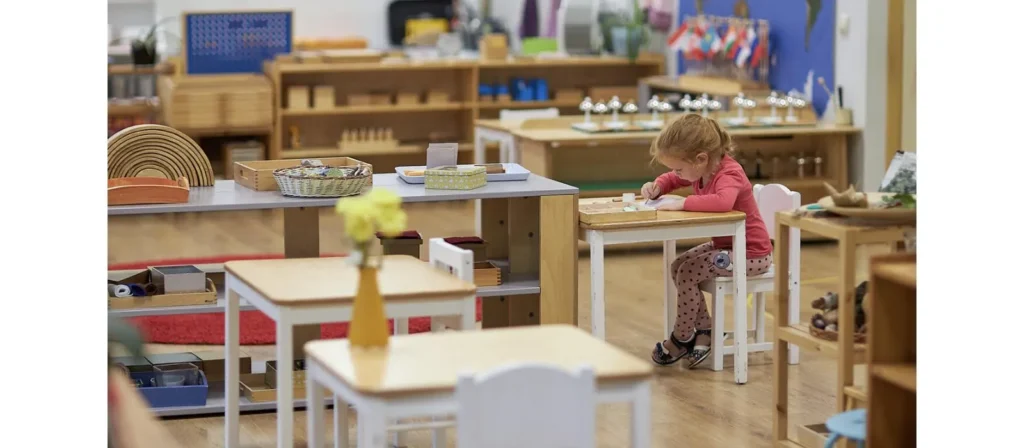
1. Child-Centered, Organized, and Accessible
In a Montessori school, everything is tailored to meet the child’s developmental needs. The room is carefully organized, and the furniture is designed to be child-sized so children can move about the space independently and freely. Materials are accessible on open shelves, allowing children to select and return them independently. This level of accessibility gives children a sense of ownership over their learning environment and fosters a greater sense of responsibility.
Montessori vs Waldorf classrooms typically feature a variety of materials that are both educational and self-correcting. Montessori materials are designed to encourage exploration and learning through hands-on experiences, such as colorful counting beads, sandpaper letters, and geometric shapes. Each material is presented in a specific way that allows children to explore independently, promoting self-discovery and critical thinking.
2. A Calm, Orderly, and Minimalist Environment
The Montessori classroom is intentionally minimalist in design. There are no unnecessary distractions, and the space is free of clutter. Every item in the room has its place, and this organizational structure helps children develop a sense of order and discipline. The calm, tidy, and orderly environment allows children to focus on their activities without feeling overwhelmed by excess stimulation.
3. Specific Learning Zones and Materials
Montessori classrooms are divided into specific learning areas, such as practical life, sensory exploration, mathematics, language, and cultural studies. Each area is designed with specific materials and activities that support developmental learning in that area. For example, the practical life area might include dressing, cleaning, and cooking activities, while the language area might feature letter-sound materials and writing tools.
Key Differences Between Waldorf vs Montessori Education
While both Waldorf education vs Montessori classrooms are child-centered, several differences set the two environments apart:
Focus on Materials: Waldorf vs Montessori
- Waldorf: Emphasizes open-ended, natural materials that encourage imagination and creativity. These materials are more artistic and are often made from natural fibers and wood.
- Montessori: Focuses on carefully designed, hands-on materials specific to each area of study. These materials are intended to help children learn academic concepts through sensory experiences.
Room Organization: Waldorf vs Montessori
- Waldorf: The classroom is designed to emphasize aesthetic beauty, warmth, and natural elements. There is often a central play area, and the space is designed to be flexible and encourage imaginative play.
- Montessori: The classroom is meticulously organized and focused on functionality. Materials are arranged on low shelves for easy access and are divided into learning zones for practical life, math, language, and more.
Teacher’s Role in Waldorf vs Montessori
The role of the teacher is central to both Waldorf vs Montessori education, yet the way teachers interact with students and guide their learning varies significantly between the two approaches. While both philosophies emphasize nurturing the whole child—intellectually, emotionally, and socially—the teacher’s role in each system reflects distinct educational values and methods.
Waldorf Education: Teacher as a Guide, Artist, and Role Model

- Holistic Educator:
In Waldorf education, the teacher’s role is deeply intertwined with the child’s spiritual, intellectual, emotional, and physical growth. The teacher is seen as a guide who helps foster development in all aspects of a child’s life, understanding that children grow in stages and need different types of support at each stage. - Creative Facilitator:
Waldorf teachers often deliver lessons in an artistic, imaginative way. They use storytelling, music, drama, and visual arts to help children understand concepts. Teachers craft lessons around the child’s developmental needs and use artistic expression to stimulate creativity and deep thinking. - Curriculum Designer:
The teacher is responsible for developing and structuring the curriculum. Waldorf schools follow a specific, structured curriculum integrating various subjects like art, music, and nature studies. Teachers plan these lessons carefully to match the child’s developmental stage, ensuring that concepts and skills are introduced in an age-appropriate way. - Classroom Presence and Authority:
Waldorf teachers stay with the same class for multiple years, often for a 3- or 6-year cycle. This long-term relationship fosters a deep understanding of each child’s needs and promotes strong bonds. The teacher has a nurturing yet authoritative role, guiding children through their emotional and intellectual development with warmth and consistency. - Moral and Spiritual Role:
Teachers in Waldorf schools often emphasize moral and ethical development and a connection to the broader spiritual world. They are considered role models for students, academically and in terms of personal behavior, ethics, and values.
Montessori Education: Teacher as a Facilitator and Observer
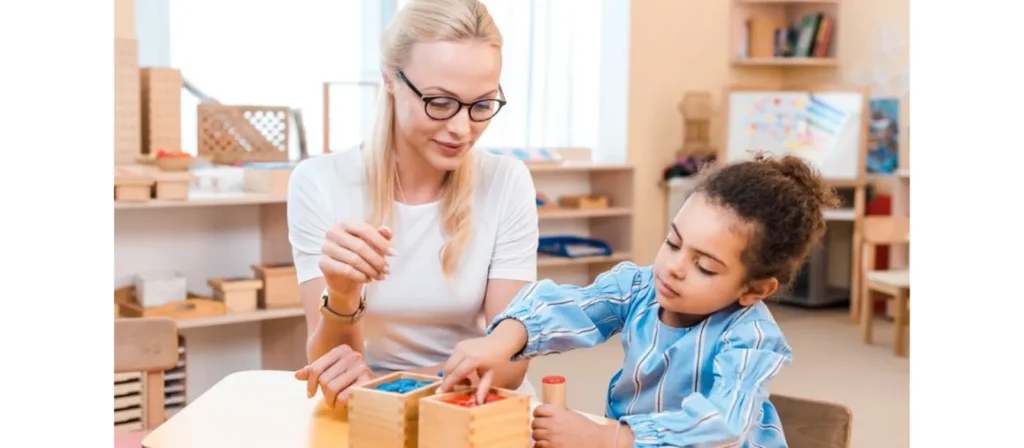
- Guide and Facilitator:
In Montessori, the teacher is a guide or facilitator rather than a traditional instructor. Teachers create a prepared environment where children can explore, learn at their own pace, and follow their natural curiosities. The teacher offers materials and activities, but the child is largely in control of their learning. - Observer and Assessor:
Montessori teachers spend significant time observing children rather than directing them. Teachers observe each child’s progress, interests, and needs and then offer appropriate activities or lessons that encourage further growth. This individualized attention helps teachers tailor their guidance to each child’s development. - Respecting Autonomy:
A core principle of Montessori education is fostering independence. The teacher respects the child’s autonomy by allowing them to choose their activities, make decisions, and solve problems. Teachers intervene only when necessary to guide the child or when requested by the child. The focus is on allowing children to develop self-discipline and personal responsibility. - Environment as the Teacher:
In Montessori, the environment is as important as the teacher. The classroom is carefully prepared with materials that are accessible, organized, and suited to the developmental stages of the children. Teachers are responsible for ensuring that the environment supports autonomy and learning but is not the primary focus of the child’s learning process. - Minimal Direct Instruction:
In Montessori, direct teaching is limited. Teachers typically present lessons individually or in small groups, demonstrating how to use the learning materials. Afterward, children are encouraged to practice and explore these concepts independently. The teacher’s role is not to lecture but to provide the tools and opportunities for the child’s independent exploration.
Key Differences in the Teacher’s Role:
Role of Authority: Waldorf vs Montessori
- Waldorf: Teachers are seen as authorities and role models, guiding the child in a more structured, nurturing, and artistic way. The teacher sets the pace and tone for the class, making decisions about when and how different subjects should be introduced.
- Montessori: The teacher is a guide, observing and facilitating rather than leading the class. The teacher intervenes minimally and allows the child to lead their learning process, promoting self-discovery.
Creativity vs. Structure: Waldorf vs Montessori
- Waldorf: Teachers are highly creative in delivering lessons, integrating the arts, and storytelling into subjects. The teacher’s creativity and ability to engage students through art, music, and drama are crucial.
- Montessori: While Montessori classrooms have creative materials, the teacher focuses on providing structured learning opportunities through carefully designed materials that encourage self-directed learning.
Interaction with Students: Waldorf vs Montessori
- Waldorf: Teachers often stay with the same group of students for multiple years, developing a deep relationship and understanding each child’s needs. This extended relationship allows teachers to tailor instruction and emotional support based on individual developmental stages.
- Montessori: Teachers typically work with children individually or in small groups, allowing for more personalized interactions. However, the teacher does not lead the class as a whole; each child can pursue their learning path at their own pace.
Emphasis on Developmental Stages: Waldorf vs Montessori
- Waldorf: Teachers are deeply attuned to the child’s developmental stages and create teaching plans around them. There is a strong focus on the whole child, including moral and spiritual development.
- Montessori: Teachers also consider developmental stages but emphasize creating an environment that allows children to learn according to their natural timeline, with less focus on the moral or spiritual aspects.
Waldorf vs Montessori: Which is Right for Your Child?

When deciding between Waldorf vs Montessori, consider your child’s temperament, learning style, and educational values. Both approaches have been proven to foster well-rounded, independent children, but the right choice depends on your child’s needs.
- Waldorf may be ideal if your child is highly imaginative, loves artistic expression, and thrives in a rhythmic, structured environment.
- Montessori might be better if your child is independent, enjoys hands-on learning, and benefits from a more structured academic approach with the freedom to choose their learning activities.
Both approaches prioritize nurturing the child’s inner potential, fostering independence, and supporting the development of social and emotional skills. Whichever method you choose, the most important thing is to trust your instincts as a parent and choose the environment that best supports your child’s growth.
Conclusion:
Choosing between Waldorf vs Montessori depends on your child’s temperament, learning style, and developmental needs. Waldorf education may better fit children who thrive in a nurturing, structured environment with a strong focus on creativity, imagination, and social-emotional growth. It is ideal for those who benefit from guided artistic expression and moral development.
Montessori education, on the other hand, is well-suited for children who prefer autonomy and self-direction. It offers an environment where children can take control of their learning, fostering independence and a love for discovery. However, it may not be best for children who need more structure or are less independent.
Ultimately, both approaches offer unique benefits and can foster a love of learning, but the right choice depends on your child’s individual needs and how they engage with the world around them.




